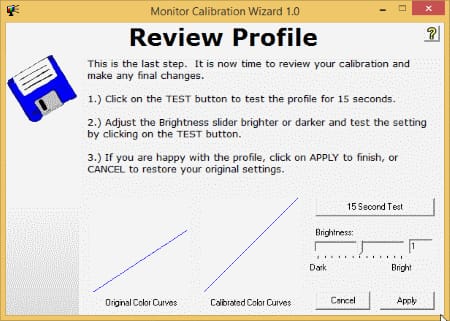
- #COLOR MONITOR CALIBRATION SOFTWARE MOVIE#
- #COLOR MONITOR CALIBRATION SOFTWARE MANUAL#
- #COLOR MONITOR CALIBRATION SOFTWARE PROFESSIONAL#
Changing the Backlight setting can usually be performed without (badly) affecting other settings. Displays with self illuminating pixels have no Backlight, although what is really Contrast may be labeled Backlight.Ī second function of Backlight is to move between Night and Daylight settings, if you cannot accurately control the viewing environment (limit daylight contamination).

The primary function of the Backlight control is to enable Peak White to be set, in conjunction with the Contrast control if available.īacklight controls are found on most LCD displays, although some displays combine this with their Brightness control. And unlike Brightness and Contrast controls, there is little chance of clipping. Depending on the display technology, the control can affect both peak white and minimum black, with more effect on white. Backlightīacklight, where available, controls the overall illumination level used for the screen, and can be used to set the overall brightness. But, it is always best to verify each mode with direct profiling. As with Picture Mode, the best setting to chose is often User or Custom. Colour ProfileĬolour Profile options (or Picture Options, or some similar name) on some displays are usually a sub-set of Picture Mode, and provides yet another level of options.
#COLOR MONITOR CALIBRATION SOFTWARE MANUAL#
If a User Mode is available, that is often the best to select, as it provides the best blank canvas with which to work, with the best selection of additional manual controls. Additionally, when selecting these modes many home TVs provide additional manual controls, as described below.
#COLOR MONITOR CALIBRATION SOFTWARE MOVIE#
This is usually Movie or Cinema mode, which contrary to their names is actually closer to a the correct colour and gamma/EOTF calibration for TV's, and has nothing to do with trying to emulate Cinema imagery. For accurate display calibration the need is to find the mode that is the least inaccurate. On Home TVs, Picture Mode selects different display-wide settings, on-top of which the other display controls work (often with different controls active or not, depending on the Picture Mode selected). An LCD monitor used for graphics should be calibrated at least once every 200–300 hours (in ordinary use, once per month). When using a monitor for graphics, stable colour can be maintained at all times by conducting calibration at a frequency of once every 200–300 hours. We recommend at least once a month, and manufacturers, such as Eizo, concur with this:

Regardless of the initial state of any factory calibration, all displays drift over time, and should be recalibrated on a regular basis. (That is not to belittle the intentions of the ISF or THX - it is just simple fact that no factory calibration can ever be accurate, as the same settings are applied en-mass to all TVs of the same model, as dictated by cost.) Unfortunately such settings are often nothing more than marketing gimmicks, as rarely are they accurate.
#COLOR MONITOR CALIBRATION SOFTWARE PROFESSIONAL#
Unfortunately, nearly all displays are provided with very poor factory calibration out of the box, especially home TVs which tend to come with over saturated colours, widely inaccurate gamma/EOTF and colour temperature, and incorrect black and white levels, with such settings aimed at looking pretty in the TV show-room.īeyond this, many TVs have what are claimed as professional calibration pre-sets, such as ISF or THX. Therefore, display calibration is required so that the viewed images match as closely as possible the colour standards expected by the images being viewed. It is equally true for Medical applications, where medical image assessment requires critical display calibration. This is true for displays used on film and TV productions, as well as for the home consumer, be it Gaming or Home Cinema use. The real requirement for display calibration is actually very obvious, as without it you will never see images as the production team, specifically the DoP & Colourist, intends.


 0 kommentar(er)
0 kommentar(er)
